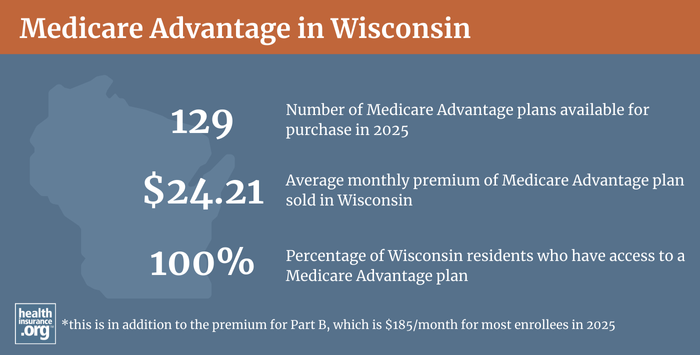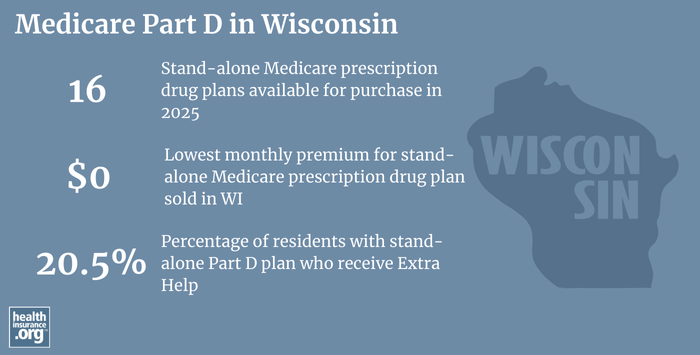Medicare in Wisconsin

More than half of Medicare beneficiaries in Wisconsin have Medicare Advantage plans; the state is one of just three that conducts its own Medigap standardization
Key takeaways
- More than 1.3 million residents are enrolled in Medicare in Wisconsin.1
- Nearly 57% of Medicare beneficiaries in Wisconsin are enrolled in Medicare Advantage plans.1
- There are Medicare Advantage plans available in every county in Wisconsin.2
- There are 16 stand-alone Medicare Part D prescription drug plans available in Wisconsin in 2025, with monthly premiums starting at $0 per month.3

Wisconsin Medicare enrollment
Medicare enrollment in Wisconsin stood at 1,317,687 people as of September 2024.1
In most cases, enrollment in Medicare goes along with turning 65. But Medicare also provides coverage for disabled individuals under age 65, once they have been receiving disability benefits for 24 months, and for people with amyotrophic lateral sclerosis (ALS) or end-stage renal disease. Nationwide, about 11% percent of Medicare beneficiaries are under age 65,4 and around the same proportion of Wisconsin beneficiaries are over 65 (10%).1
Medicare options
Medicare beneficiaries can choose from among several options to access Medicare coverage. The first choice is between Medicare Advantage plans or Original Medicare, where coverage is paid for directly by the federal government. There are pros and cons to either option, and the right solution is different for each person.
Medicare beneficiaries also have options around Medigap policies and Medicare Part D (prescription drug) coverage.
The Medicare’s Annual Election Period (October 15 to December 7 each year) allows Medicare beneficiaries the chance to switch between Medicare Advantage and Original Medicare (and add, drop, or change to a different Medicare Part D prescription drug plan). And people who are already enrolled in Medicare Advantage also have the option to change to a different Medicare Advantage plan or to Original Medicare during the Medicare Advantage Open Enrollment Period, which runs from January 1 to March 31.
Learn about Medicare plan options in Wisconsin by contacting a licensed agent.



Explore our other comprehensive guides to coverage in Wisconsin

We’ve created this guide to help you understand the Wisconsin health insurance options available to you and your family, and to help you select the coverage that will best fit your needs and budget.


Hoping to improve your smile? Dental insurance may be a smart addition to your health coverage. Our guide explores dental coverage options in Wisconsin.


Learn about Wisconsin’s Medicaid expansion, the state’s Medicaid enrollment and Medicaid eligibility.


Short-term health plans provide temporary health insurance for consumers who may find themselves without comprehensive coverage. Learn more about short-term plan availability in Wisconsin.

Frequently asked questions about Medicare in Wisconsin
What is Original Medicare?
Original Medicare coverage is provided directly by the federal government, and enrollees have access to a nationwide network of providers. But people with Original Medicare need supplemental coverage (from an employer-sponsored plan, Medicaid, or privately purchased plans) for things like prescription drugs and out-of-pocket costs (i.e., premiums, deductibles, copayments, and coinsurance), which are not capped under Original Medicare.
Original Medicare includes Part A (also called hospital insurance, because it helps to pay for inpatient stays in a hospital, skilled nursing facility, or hospice center) and Part B (also called medical insurance, which helps pay for outpatient and physician care like a doctor appointment or preventive healthcare services).
What is Medicare Advantage?
Medicare Advantage includes all of the coverage provided by Medicare Parts A and Medicare Part B, and the plans often include additional benefits, usually including integrated Medicare Part D prescription drug coverage and often including coverage for things like dental and vision care. But Medicare Advantage insurers establish their own provider networks, which are generally localized and more limited than the nationwide network for Original Medicare. Out-of-pocket costs for Medicare Advantage are often higher than they would be if a beneficiary had Original Medicare plus a Medigap plan.
Medicare Advantage plans in Wisconsin are available statewide, and residents in nearly every county have access to at least 10 Medicare Advantage plans in 2025. In some counties, there are more than 40 Medicare Advantage plans for sale.2
As of September 2024, there were 754,294 Wisconsin Medicare beneficiaries enrolled in Medicare Advantage coverage.1

What is Medigap?
Original Medicare does not limit out-of-pocket costs, so most enrollees maintain some form of supplemental coverage. Nationwide, more 80% of Original Medicare beneficiaries have a supplemental plan.5 Medigap plans (also known as Medicare supplement insurance plans, or MedSupp) will pay some or all of the out-of-pocket costs they would otherwise have to pay if they had only Original Medicare.
Although private insurers sell Medigap plans, the policies in nearly every state are standardized under federal rules.6 But Wisconsin is one of just three states that have waivers from the federal government allowing the state to conduct its own Medigap standardization.7 So, Medigap plans in Wisconsin are not the same as they are in most of the rest of the country.8
Instead of having ten different plan designs available (as is the case in most states), Wisconsin Medigap is structured so that there’s one Medigap Basic Plan. Then enrollees can choose to add riders that make the coverage more comprehensive.8 So instead of buying “Plan G” (as newly-eligible enrollees in many states would do if they want the most comprehensive Medigap plan), Wisconsin Medigap enrollees buy the Medicare Basic Plan and then add on the optional riders.
Wisconsin Medigap insurers have to offer “basic benefits” that include coverage for Medicare Part A coinsurance (including the Medicare Part A hospice coinsurance and hospital coinsurance), Medicare Part B coinsurance, and up to three pints of blood each year. Each Wisconsin Medigap insurer has to offer a “Basic Plan,” which includes the basic benefits in addition to Medicare Part A skilled nursing facility coinsurance, additional coverage for home health care and inpatient mental health care (both have limits on the number of days that are covered), outpatient mental health care, and Wisconsin state-mandated benefits.9
In addition, Wisconsin Medigap insurers can offer up to three optional policy riders that beneficiaries can purchase, with coverage for things like the Medicare Part A deductible, additional home health care, the Medicare Part B deductible and excess charges, and foreign travel coverage for emergencies abroad10 (people who are newly eligible for Medicare in 2020 or later are not be able to purchase Medigap coverage for the Medicare Part B deductible; those who already had this coverage can keep it, and people who became eligible for Medicare prior to 2020 can still purchase it, assuming they can meet the medical underwriting requirements; this applies nationwide, under the terms of the Medicare Access and CHIP Reauthorization Act of 2015).11
So if a person in Wisconsin wants a Medigap plan that’s comparable to Medigap Plan G sold in other states, they would need to buy the Basic Plan plus riders for the Medicare Part A deductible, Medicare Part B excess charges, additional home health care benefits, and foreign travel emergency coverage. Medigap coverage similar to the various lettered plans sold in other states can thus be obtained in Wisconsin by layering various riders on top of the Basic Plan.12
Medigap insurers in Wisconsin can also offer cost-sharing plans that require the member to pay a portion of the out-of-pocket costs until they reach a specified out-of-pocket limit (similar to Medigap Plans K and L that are sold in other states), and high-deductible plans that require the member the pay all costs until they meet the deductible for the year (similar to the high-deductible versions of Medigap Plans F and G that are sold in other states).12
There are 129 Medicare Advantage plans are available in WI in 2025, compared to 118 plans in 2024.3 Availability does vary depending on county.
301,581 Wisconsin Medicare beneficiaries had Medigap coverage as of 2022, according to America’s Health Insurance Plans (AHIP) analysis.): 13
Medigap insurers in Wisconsin can choose to use attained-age rating (rates increase as an enrollee gets older) or issue-age rating (rates are based on the age the person was when they enrolled).12
Unlike other Medicare plan coverage (Medicare Advantage and Medicare Part D prescription drug plans), there is no annual open enrollment window for Medigap plans. Instead, federal rules provide a one-time six-month window when Medigap coverage is guaranteed-issue. This window starts when a person is at least 65 and enrolled in Medicare Part B (you must be enrolled in both Part A and Part B to buy a Medigap plan).14
Can I get Medigap in Wisconsin if I'm under 65 and disabled?
People who aren’t yet 65 can enroll in Medicare if they’re disabled and have been receiving disability benefits for at least two years. About 12% of Medicare beneficiaries in Wisconsin are under age 65. Federal rules do not guarantee access to Medigap plans for people who are under 65, but the majority of the states — including Wisconsin — have implemented rules to ensure that disabled Medicare beneficiaries have at least some access to Medigap plans.
Medigap insurers in Wisconsin are required to offer coverage to disabled enrollees under age 65, with the same six-month open enrollment period that begins when the person is enrolled in Medicare Part B. But premiums for people under the age of 65 are considerably higher than premiums for people who are 65 and over. And insurers are only required to offer the Medigap Basic Plan to applicants under the age of 65. There are only a handful of insurers that offer any other plans.
Disabled Medicare beneficiaries also have access to the Medigap Open Enrollment Period when they turn 65. At that point, they can select from among any of the available Medigap plans in their state, with lower premiums that apply to people who are aging onto Medicare when they turn 65.
Disabled Medicare beneficiaries have the option to enroll in a Medicare Advantage plan instead of Original Medicare, and the premiums are not higher for those under 65. But as noted above, Medicare Advantage plans may have more limited provider networks than Original Medicare, and total out-of-pocket costs can be as high as $9,350 in 202515 for in-network care, plus the out-of-pocket cost of prescription drugs.
Although the Affordable Care Act eliminated pre-existing condition exclusions in most of the private health insurance market, those rules don’t apply to Medigap plans. Medigap insurers can impose a pre-existing condition waiting period of up to six months if you didn’t have at least six months of continuous coverage prior to your enrollment (although many of them choose not to do so). And if you apply for a Medigap plan after your initial enrollment window closes (assuming you aren’t eligible for one of the limited guaranteed-issue rights), the Medigap insurer can consider your medical history in determining whether to accept your application, and at what premium.
What is Medicare Part D?
Original Medicare does not provide coverage for outpatient prescription drugs. More than 80% of Original Medicare beneficiaries have a supplemental plan, and these plans often include prescription coverage.5
Medicare beneficiaries who do not have Medicaid or employer-sponsored prescription drug coverage may need Medicare Part D prescription drug plan enrollment in order to have coverage for prescriptions. Medicare Part D was created under the Medicare Modernization Act of 2003, and can be purchased as a stand-alone plan, or obtained as part of a Medicare Advantage with built-in Medicare Part D prescription drug plan coverage.
There are 16 stand-alone Medicare Part D prescription drug plans in Wisconsin in 2023, with premiums starting at $0 per month.3
About 410,704 of Wisconsin’s Original Medicare beneficiaries had stand-alone Medicare Part D plans as of September 2024.1 Another 632,883 Wisconsin Medicare beneficiaries had Medicare Part D prescription drug coverage integrated with their Medicare Advantage plans.1 Because more than half of Wisconsin’s Medicare beneficiaries have Medicare Advantage plans, the number of people covered by Medicare Part D prescription drug plans integrated with Medicare Advantage is higher than the number of people with stand-alone Medicare Part D prescription drug coverage.
Medicare Part D prescription drug plan enrollment is available during a beneficiary’s initial enrollment period (when they turn 65 or become eligible for Medicare due to a disability), and there is also the Medicare Annual Open Enrollment Period each fall. During this window, beneficiaries can switch to a different Medicare Part D prescription drug plan or enroll for the first time (with a late enrollment penalty, depending on the circumstances), with coverage effective the following January.

How does Medicaid provide financial assistance to Medicare beneficiaries in Wisconsin?
Many Medicare beneficiaries receive financial assistance through Medicaid with the cost of Medicare premiums and services Medicare doesn’t cover – such as long-term care.
Our guide to financial assistance for Medicare enrollees in Wisconsin includes overviews of these benefits, including Medicare Savings Programs, long-term care coverage, and eligibility guidelines for assistance.
What additional resources are available for Medicare beneficiaries and their caregivers in Wisconsin?
Need help with your Medicare application in Wisconsin, or have questions about Medicare eligibility in Wisconsin? These resources provide free assistance and information.
- The website for the Wisconsin Department of Health Services has a comprehensive list of resources related to Medicare coverage in Wisconsin.
- Visit the Medicare Rights Center. This website provides helpful information geared to Medicare beneficiaries, caregivers, and professionals.
Louise Norris is an individual health insurance broker who has been writing about health insurance and health reform since 2006. She has written dozens of opinions and educational pieces about the Affordable Care Act for healthinsurance.org.
Footnotes
- “Medicare Monthly Enrollment – Wisconsin.” Centers for Medicare & Medicaid Services Data. Accessed January, 2025. ⤶ ⤶ ⤶ ⤶ ⤶ ⤶ ⤶
- ”Medicare Advantage 2025 Spotlight: First Look” KFF.org Nov. 15, 2024 ⤶ ⤶
- ”Fact Sheet: Medicare Open Enrollment for 2025” (149) Centers for Medicare & Medicaid Services. Sep. 27, 2024 ⤶ ⤶ ⤶
- “Medicare Monthly Enrollment – US” Centers for Medicare & Medicaid Services Data, November 2024. ⤶
- Ochieng, Nancy, and Jeannie Fuglesten Biniek. “Cost-Related Problems Are Less Common among Beneficiaries in Traditional Medicare than in Medicare Advantage, Mainly Due to Supplemental Coverage.” Kaiser Family Foundation, July 7, 2021. ⤶ ⤶
- “Get Medigap Basics.” Medicare.gov. Accessed August 22, 2023. ⤶
- “Get Medigap Basics.” Medicare.gov. Accessed August 9, 2023. ⤶
- “Medigap in Wisconsin.” Medicare.gov. Accessed August 9, 2023. ⤶ ⤶
- “2023 Guide to Health Insurance for People with Medicare in Wisconsin.” Page 24. oci.wi.gov, February 2023. ⤶
- “Supplement Insurance (Medigap) Plans in Wisconsin.” Find a Medicare plan. Accessed August 8, 2023. ⤶
- “H.R.2 – Medicare Access and CHIP Reauthorization Act of 2015.” Congress.gov. Accessed August 22, 2023. ⤶
- “2023 Guide to Health Insurance for People with Medicare in Wisconsin.” oci.wi.gov, February 2023. ⤶ ⤶ ⤶
- ”The State of Medicare Supplement Coverage” AHIP. May 2024 ⤶
- “Get Ready to Buy.” Medicare. Accessed June 28, 2023. ⤶
- ”Final Contract Year (CY) 2025 Standards for Part C Benefits, Bid Review and Evaluation” Centers for Medicare & Medicaid Services. May 6, 2024 ⤶

